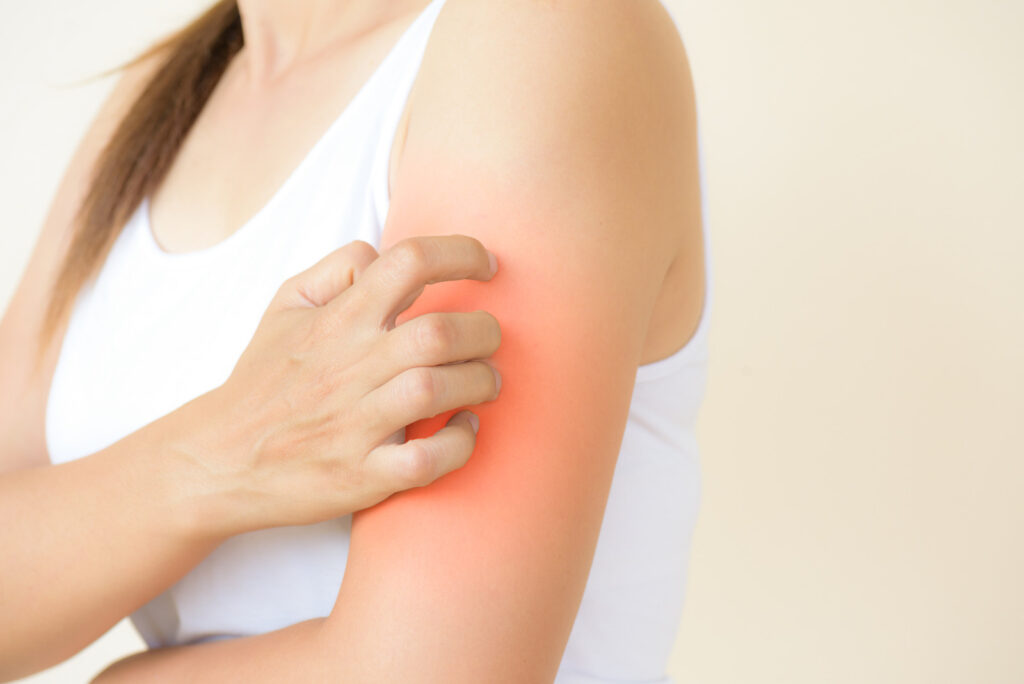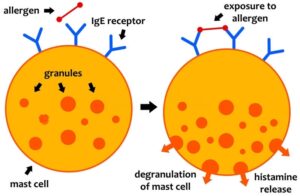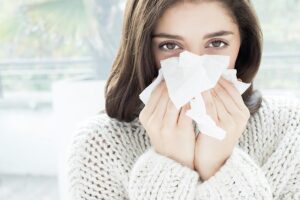
“Allergies are, in a sense, a failure to communicate between our body and the environment.”
– Dr. James Hamblin
We all know inflammation and its symptoms (heat, swelling, pain, and redness). But many of us don’t know that the release of histamine can trigger inflammation. In this blog post, we will explore the connection between histamine intolerance and pain, what histamine is, where it comes from, how to address it with The Hache Protocol naturally, and ways to work around histamine intolerance.
What is Histamine?

Ever pet a friendly neighborhood cat or smell a pretty flower only to end up all itchy with watering eyes? That’s histamine at work! Histamine is a natural compound produced by the body and found in certain foods.
It is a neurotransmitter that helps send signals between nerve cells in the brain, spinal cord, and more. Histamine is also involved in the immune response, where it protects the body from harmful invaders.
When the body detects something foreign, like a virus or bacteria, specific cells called basophils and mast cells produce histamine (see picture above).
Next, histamine triggers a chemical process that causes the small blood vessels (called capillaries) near the infected area to become more permeable, allowing white blood cells and proteins to pass through and fight off the foreign substance.
Where Does Histamine Come From?
As I mentioned earlier, mast cells and basophils are the primary cells that release histamine in response to an immune system trigger.
Additionally, some medications, such as opioids and muscle relaxants, can cause histamine release as a side effect. Stress, exercise, certain foods, and environmental triggers like pollen and dust mites can also contribute to histamine release in the body. This makes histamine intolerance a big deal in the Spring when many of us are battling allergens.
Histamine Intolerance

Histamine intolerance causes a range of symptoms, including inflammation and pain. While histamine intolerance is not well understood, it is estimated to affect up to 1-3% of the population.
Symptoms of Histamine Intolerance include:
- Headaches or migraines
- Hives or skin rashes
- Flushing or redness of the skin
- Swelling or inflammation, especially in the face or throat
- Itchy or watery eyes
- Runny or stuffy nose
- Digestive issues, such as bloating, gas, diarrhea, or constipation
- Joint pain or stiffness
- Fatigue or brain fog
- Anxiety, Depression, or irritability
It’s important to note that these symptoms can vary from person to person, and some people may experience only a few or none of these symptoms. If you suspect you have histamine intolerance, it’s best to talk to a healthcare professional for a proper diagnosis.
How Does Histamine Intolerance Cause Pain?
Histamine intolerance can cause pain by triggering an inflammatory response in the body. When histamine levels are high, it can cause blood vessels to dilate, leading to increased blood flow to the affected area. This can cause swelling, redness, and pain.
The Hache Protocol and Histamine Intolerance
The Hache Protocol is a natural approach to addressing histamine intolerance and reducing inflammatory pain. The protocol was developed by Drs. John and Lorry Hache, world-leading experts in the natural treatment of chronic pain.
In our smash-hit book, Current Medicine 3rd Edition, we have included a few of our favorite microcurrent protocols for dealing with histamine intolerance. We’ll cover those next!
Microcurrent For Allergies and Histamine Intolerance
Research has found that allergic conditions now afflict roughly 25% of people in the developed world. One example of chronic allergic inflammation is rhinosinusitis, a condition in which the sinuses become inflamed for months to years on end, causing difficulty breathing.
Allergic rhinitis is marked by sneezing followed by nasal discharge, nasal congestion, itching, watering of the eyes, and sometimes conjunctivitis. It may also trigger, in some instances, an asthma attack or hives.
The following protocols may be a better option than seasonal allergy shots and substance testing, which is an overly aggressive procedure for young children. Sure, antihistamines or decongestants may help with mild seasonal allergies, but the more chronic cases require a deeper, more systemic approach.
Microcurrent Protocols for Histamine Intolerance:
- Vagus Nerve Stimulation
- Immune Booster Protocol
- Pirogov’s Ring
Learn how to perform Pirogov’s Ring Protocol in the short video below:
Ways to Work Around Histamine Intolerance
In addition to following The Hache Protocol, there are other ways to work around histamine intolerance:
- Avoid high histamine foods: Think: aged cheese, fermented foods, cured meats, and alcohol.
- Choose fresh foods: Fresh foods are generally lower in histamine than processed foods. Choose fresh fruits, vegetables, and meats whenever possible.
- Consider supplements: Certain supplements, such as quercetin and vitamin C, can help to reduce histamine levels in the body.
- Reduce stress: Stress can exacerbate histamine intolerance and pain. Engage in stress-reducing activities as part of your daily routine.
- Consider food preparation: Cooking and freezing can help reduce histamine levels in foods. Freshly steamed veggies from the farmer’s market are my go-to!
- Be aware of histamine-rich additives: Some foods, such as artificial colors and preservatives, contain histamine-rich additives. Read food labels and avoid foods that contain these additives.
High Histamine Foods to Avoid

If you’re a fan of a charcuterie board with a bold glass of wine, I’m sorry to report that they may be one of the worst choices food-wise if histamine intolerance is an issue. This is because almost every ingredient on a charcuterie board contains high histamines, from the aged cheeses to the inflammatory red meat sausages, down to the spicy smear of Dijon mustard and the velvety glass of Pinot you wash it all down with.
Avoid these foods if you suffer from any of the common symptoms of histamine intolerance listed above.
- Aged cheese (such as cheddar, blue cheese, and parmesan)
- Fermented foods (such as sauerkraut, kimchi, and pickles)
- Cured meats (such as salami, ham, and bacon)
- Shellfish (such as shrimp, crab, and lobster)
- Alcoholic beverages (such as beer, wine, and liquor)
- Vinegar and vinegar-containing foods (such as mayonnaise and salad dressings)
You may have read our blog on the benefits of fermented foods for gut health and wondered, “which is it, are fermented foods good for health or not?”. And the answer to that question will depend on your individual constitution and your healthcare provider’s recommendations.
If you’re histamine sensitive, or think you may be, try cutting the foods listed above out of your diet and see how it affects your pain levels.
What Are Histamine Liberators?
Foods that release histamines in other foods are known as histamine liberators. These foods have low levels of histamines but can trigger the release of histamines in other foods. Limiting the intake of histamine liberators is advisable, although it may not be necessary to cleanse them from your diet completely.
Examples of histamine liberators include:
- Fruits such as kiwi, lemon, lime, papaya, and pineapple
- Cocoa
- Nuts
- Beans and pulses
Histamine and Inflammation Flare-Ups: Stop the Cycle
By following The Hache Protocol and making dietary and lifestyle changes, it is possible to reduce histamine intolerance and alleviate pain naturally. Avoiding high-histamine foods and considering supplements are additional strategies that can help manage histamine intolerance.
If you suffer from chronic pain, consider exploring natural pain resolution methods such as microcurrent therapy and other forms of energy medicine to find relief.
Sources cited:
The development of allergic inflammation – PubMed (nih.gov)
Histamine could be a key player in depression, according to study in mice — ScienceDaily
Histamine intolerance: Causes, symptoms, and test (medicalnewstoday.com)





